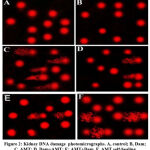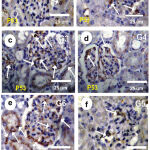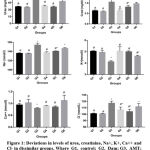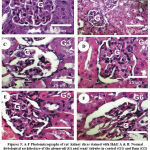Ahmed F. Hasan1, Haneen M. Hameed 1, Ehab Tousson2* , Ahmed Massoud2, Fathy Atta2, Hussein Youssef3
, Ahmed Massoud2, Fathy Atta2, Hussein Youssef3 and Youssef Hussein3,4
and Youssef Hussein3,4
1Department of Biology, Al-Farabi University College , Baghdad, Iraq
2Zoology Department, Faculty of Science, Tanta University, Tanta, Egypt
3Faculty of medicine, Zagazig University, Zagazig, Egypt.
4Faculty of medicine, Mutah University, Jordan.
Corresponding Author E-mail: ehabtousson@science.tanta.edu.eg
DOI : https://dx.doi.org/10.13005/bpj/2460
Abstract
Major depressive disorder and anxiety disorders are two mental diseases that are treated with amitriptyline (AMT). AMT treatments induced liver, heart and testes toxicity; As a result, the purpose of this study was to determine the preventative and therapeutic role of damiana (Dam) as adjuvant herbal therapy against AMT induced heart injury in rats. Six groups of 36 rats (male albino) were randomly assigned; first one is control, second is Dam, third was AMT, fourth was Dam+AMT, fifth was AMT+Dam and sixth was AMT self-healing. A significant elevation in creatinine, urea, sodium (Na+), Chloride (Cl+), renal injury, DNA damage and apoptosis in treatment rats with amitriptyline and self-healing group as related to control and damiana groups. Conversely; potassium (K+) and calcium (Ca++) were a significant decrease in AMT and self-healing groups as compared with control. Treatment of AMT with Dam (Co and Post) revealed a modulation and improvement of renal toxicity with best result in co- treatments than post treatments. As a result, AMT treatments encouraged changes in kidney functions and structure and the post-treatments of AMT with dam modulates these alterations.
Keywords
Amitriptyline; Damiana; DNA damage; Kidney; P53
Download this article as:| Copy the following to cite this article: Hasan A. F, Hameed H. M, Tousson E, Massoud A, Atta F, Youssef H, Hussein Y. Role of Oral Supplementation of Damiana (Turnera diffusa) Reduces the Renal Toxicity, Apoptosis and DNA Damage Associated with Amitriptyline Administration in Rats. Biomed Pharmacol J 2022;15(3). |
| Copy the following to cite this URL: Hasan A. F, Hameed H. M, Tousson E, Massoud A, Atta F, Youssef H, Hussein Y. Role of Oral Supplementation of Damiana (Turnera diffusa) Reduces the Renal Toxicity, Apoptosis and DNA Damage Associated with Amitriptyline Administration in Rats. Biomed Pharmacol J 2022;15(3). Available from: https://bit.ly/3RBeW6l |
Introduction
Depression is a psychoneurotic issue described by mental and utilitarian action.1 Each medication used to treat depression called antidepressant medication and it works by adjusting synthetic uneven characteristics of synapses inside the brain.2,3 Antidepressants are a class of medications used to treat the side effects of burdensome issues Chemical lopsided characteristics could likewise be chargeable for changes in the state of mind and behavior.4,5
Amitriptyline is a tricyclic stimulant (TCA) used to treat various psychological sicknesses incorporating significant burdensome problem and nervousness issue, and less generally consideration shortage hyperactivity jumble and bipolar issue, different purposes incorporate counteraction of headaches, therapy of neuropathic agony, for example, fibromyalgia and postherpetic neuralgia, and less ordinarily insomnia.6,7 AMT is known to inhibit serotonin and norepinephrine reuptake at the presynaptic level, increasing the clustering of the two synapses at the synaptic interface.8 As of late, AMT was viewed as an inhibitor of mitochondrial capacities that are answerable for the development of ROS and for setting off the modified cell demise or apoptosis.9-11 Amitriptyline treatment actuated oxidative pressure and apoptosis in a few tissues, including the mind, in a portion subordinate way.
Alternative medicines for the treatment of a number of human disorders have been the subject of several pieces of research.12-15 Several phytochemicals were presented to be threatened and possibly valuable therapeutically.16-18 Damiana (Turnera diffusa Willd) is a restorative plant generally utilized as an energizer, diuretic and Spanish fly; it is additionally regularly utilized for the arrangement of mixtures and alcohols, and in the development of corrective items, cleansers, gelatins, chocolates, and in conventional medicine.10,19,20 It has been proposed that damiana has a lot of natural balms and cancer prevention agents, especially flavonoids, which could be answerable for its restorative properties.21,22 Due to late revelations of new metabolites in and expected utilization of damiana, there is rising attention, especially from of the clinical and drug enterprises, on its way of life and business corruption.23,24 Dam has been shown to have a protective effect against exploratory hepatotoxicity by regulating the ultra-structures of liver cells and affecting the presentation of liver enzymes.25
As a result, the purpose of this research was to look at the effects of Damiana (Dam) against the apoptosis, DNA damage, and toxicity induced by Amitriptyline (AMT) administration in kidney.
Materials and methods
Damiana’s aqueous extracts production
Dam dried leaves were shacked to powder and soaked in boiled water for 24 hours at 37C then extract and stored at -30˚C in the dark until used.11
Experimental animals
36 rats (male albino) were brought from the Giza NRC, Egypt, at the age of 10-12 weeks and weighing roughly 150 g. The Ethical local committee agreed to design the experiment according to the guidelines of the Faculty of Science, Tanta University with the approval of the Institutional Animal Care and Use Committee (IACUC-SCI-TU-0049). Six groups of 36 rats (male albino) were randomly assigned; first one is control, second is Dam (80 mg Dam/kg body weight/daily/ orally) for 4 weeks, third was AMT (70 mg amitriptyline/kg body weight/daily/intraperitoneally injected) for 4 weeks, fourth was Co-treated Amitriptyline with Damiana (Dam+AMT), fifth was post-treated Amitriptyline with Damiana (AMT+Dam) and sixth was AMT self-healing. The rats were starved overnight at the end of the experiment. Each group’s rats were euthanized with sodium pentobarbital to allow for full dissection.
Blood and serum samples
Sera were taken and centrifuged at 4000 rpm for 12 Min to separate it and to determine different blood parameters.
Electrolytes and kidney functions Biomarker
Levels of urea and creatinine were assessed according to Patton and Crouch26 and Bowers and Wong27 correspondingly. Electrolytes levels were assessed according to Abd Eldaim et al.28
Comet Assay
A comet assay approach developed from earlier available journals was used to analyse and quantify DNA damage in tissue of the kidney.29
Histopathological examination
According to Tousson;30 kidney tissues were removed and promptly fixed in neutral formalin at 10% concentration for 2 days before being processed for paraffin sectioning and H&E staining.
Immunohistochemical detection of P53 immunoreactivity
Conferring to Tousson et al.31,32, apoptotic P53 in kidney was distinguished through the Avidin-Biotin-Complex method.
Statistical Analysis
Current data were offered as means with standard – error of main. One-way ANOVA was used to parallel data between the amitriptyline group and the other five groups at p0.05, the P value was significant. The analysis was carried out with the help of a Graphpad prism.
Results
Changes in kidney functions and electrolytes in different groups
When AMT and self-treated AMT groups were associated to control and Dam groups, urea, creatinine, Na+, and Cl– levels were significantly higher in the groups of AMT and self-healing AMT. When comparing the groups of AMT and self-treated AMT to the groups of control and Dam, serum potassium (K+) and calcium ions (Ca++) were significantly lower in the AMT and AMT self-cured groups (Figure 1).
When AMT treated with Dam (co and post) groups were associated with AMT and AMT self-healing groups, serum urea, creatinine, Na+, and Cl– levels showed a substantial decrease. When compared to amitriptyline and self-treated AMT groups, co-treated AMT and post-treated AMT with Dam groups showed a substantial rise in K+ and Ca++ levels (Figure 1).
DNA damage in kidney
Figure (2) and tables (1) revealed kidney DNA damage in tissues. When associated with the control and Dam groups, the AMT group confirmed elevation in DNA damage (P 0.05), as seen by increases in tail length, tail DNA percent, and tail moment. This enhanced kidney DNA damage was reduced in Dam+AMT, AMT+Dam, and self-cured.
 |
Figure 2: Kidney DNA damage photomicrographs. A, control; B, Dam; C, AMT; D, Dam+AMT; E: AMT+Dam, F, AMT self-healing. |
Table 1: Kidney DNA damage with Comet assay constraints achieved by image analysis in all group cells.
| Group | Tailed % | Untailed % | Tails length µm | Tail DNA% | Tail moment |
| G1 | 1.5 | 98.5 | 1.40d±0.13 | 1.49 | 2.09 |
| G2 | 3 | 97 | 1.52d±0.14 | 1.63 | 2.48 |
| G3 | 23 | 77 | 8.11a±0.38 | 5.37 | 43.55 |
| G4 | 7 | 93 | 3.40c±0.15 | 2.41 | 8.19 |
| G5 | 14.5 | 85.5 | 6.07c±0.25 | 3.83 | 23.25 |
| G6 | 8 | 92 | 3.75b±0.17 | 2.62 | 9.83 |
Data are expressed as mean ± SE for tail length and as percentage for other parameters. Values carrying the different letters in the same row were significantly different at P< 0.05. Where, G1, control group; G2, Damiana group; G3, Amitriptyline group; G4, co- treated group; G5, post-treated group; G6, self-treated groups.
Kidney histopathology results
Our results revealed that; Malpighian corpuscles and both proximal and distal convoluted tubules are normal in both control and Dam kidneys (Figures 3A&3B). In contrast; Malpighian corpuscles lost their characteristic configuration, and renal tubules with wide lumen, moderate haemorrhage, mild to moderate atrophic glomerulus and degenerated epithelium, were seen in kidney of AMT and in AMT self-healing groups (Figures 3C&3F). However; kidney in Dam+AMT and AMT+Dam revealed a good improvement with only negligible vacuolization in renal tubules as compared to AMT and in AMT self-healing groups (Figures 3D&3E).
P53 immunohistochemical changes in Kidney
Immunohistochemistry staining of kidney from the control (G1) and Dam (G2) groups revealed minor positive expression of P53 (grade 2) in the glomeruli and renal tubules (Figures 4A&4B). The glomeruli and renal tubules in the kidneys of AMT (G3) and AMT self-healing (G6) groups showed a heavy positive expression (grade 5) for P53 (Figures 4C&4F). In kidney sections of rats in Dam+AMT (G4) and AMT+Dam (G5), revealed moderate and mild to moderate positive expressions for P53 (grades 4&5 respectively) (Figures 4D&4E).
 |
Figure 4: (A-F). Kidney section Photomicrograph in rat stained with apoptotic P53. A & B: Minor positive (arrows) reactions for P53 were detected in control and dam treated groups. C & F: |
Discussion
The kidney is a compound cylindrical organ worried about the significant capacity of excretion.33,34 It removes foreign items, discharges urea and other nitrogenous wastes, and maintains homeostasis by managing the organisation, volume, and strain of blood.35 Medications are a common cause of kidney impairment, often known as nephrotoxicity or, in severe cases, renal disappointment. This suggests renal damage, and plasma creatinine levels were found to be elevated in relation to the histological findings. The study assumes that antidepressant medication will have an impact on the vital organs. As a result, these effects must be considered while administering antidepressants to depressed patients.
In the current study; a critical expansion in creatinine, urea, Na+ and Cl– and a marked decline in K+ and Ca++ levels was identified in after treatments with AMT when differentiated from control. Current outcomes were steady with Tousson et al.36 who announced that; amitriptyline instigated an expansion in sodium particle levels and reduction in potassium particles level. In the current review, expanded urea, and creatinine levels mirror the finding of renal failure.37,38 Moreover, raised blood urea is known to be related to expanded protein catabolism in well evolved creatures and additionally the change of alkali to urea because of the expanded blend of arginase chemical engaged with urea creation. The rise in serum urea and creatinine levels in AMT-treated rodents is considered a critical marker of renal brokenness and might be connected with metabolic aggravations in liver capacity, as urea is the final result of protein catabolism. Besides, xenobiotics escalate the corrosive secretory capacity of kidney and change the vehicle of sodium.39 This is reliable with the current outcomes where Na+ and K+ were changed in rodents treated with AMT. organization of Dam shields the kidney capacities from AMT inebriation as demonstrated by a huge rebuilding of serum urea, creatinine, and electrolytes.
Various human chronic diseases have been connected with the changed oxidative pressure, created either through the expansion of the free extreme age as well as a compromised cancer prevention agent level in the objective cells and tissues.40 These free revolutionaries produced prompt DNA strand breaks and causes oxidative alteration of the DNA bases.41 DNA harms were performed with comet measure in kidney tissues. In the ongoing review; Amitriptyline actuated a huge expansion in kidney and liver DNA harm (P < 0.05) that was demonstrated by expansion in tail length, tail DNA% and tail second when contrasted with ordinary control and damiana gatherings. This expanded DNA harm was decreased in co-treated (G4), post-treated (G5), self-healing (G6) with consumption harm in G4 and G6. Our outcomes concur with Tousson et al.10 and Hasan et al.11 who find that; amitriptyline made DNA damage in testes and liver respectively and the treatments with damiana modulate this DNA damage.
Apoptosis is a significant cycle for holding cell numbers under control, without influencing cell replication augmentation notwithstanding it stops the phone cycle at G1 and G2 if there should be an occurrence of DNA harm, permitting the actuation of DNA fixing proteins.42-44 In the ongoing review; apoptotic P53 articulations were fundamentally expanded in kidney tissues in amitriptyline bunch as contrasted and control recognized amitriptyline incited apoptosis, additionally treatment amitriptyline with damiana balances these progressions in P53.
Conclusion
AMT treatments encouraged changes in kidney functions and structure and the post-treatments of AMT with dam modulates these alterations.
Conflict of Interest
Authors have declared that no competing interests exist.
Funding Sources
The author(s) received no financial support for the research, authorship, and/or publication of this article.
References
- Darton TC, Jones C, Blohmke CJ, Waddington CS, Zhou L, Peters A, Haworth K, Sie R, Green CA, Jeppesen CA, Moore M. Using a human challenge model of infection to measure vaccine efficacy: a randomised, controlled trial comparing the typhoid vaccines M01ZH09 with placebo and Ty21a. PLoS neglected tropical diseases. 2016 Aug 17;10(8):e0004926.
CrossRef - Jespersen S. Antidepressant induced sexual dysfunction Part 2: assessment and management. South African Psychiatry Review. 2006 May 1;9(2):79-83.
CrossRef - Jhansi K, Vanita P, Lavanya S, Satya V. A Review on Antidepressant Drugs. Adv Pharmacoepidemiol Drug Saf. 2014;3(1):1-2.
- Fonseca AP, Leala V. Use of Antidepressants to Treat Postpartum Depression, During Breast Feeding. J Depress Anxiety. 2014;3(148):2167-1044.
- Ghoneim M, Saber AL, El-Desoky H. Utility spectrophotometric and chromatographic methods for determination of antidepressant drug sulpiride in pharmaceutical formulations and plasma. Journal of Analytical & Bioanalytical Techniques. 2014 Mar 1;5(2):1.
CrossRef - George S, Acharya LD, Mallayasamy S. Management and treatment outcome of complications of chronic kidney disease patients in a South Indian tertiary care hospital. International Journal of Pharmacology and Clinical Sciences. 2013;2(4).
- Shabana KM, Buchholtz AK, Carroll AB. The institutionalization of corporate social responsibility reporting. Business & Society. 2017 Nov;56(8):1107-35.
CrossRef - Mika J, Zychowska M, Makuch W, Rojewska E, Przewlocka B. Neuronal and immunological basis of action of antidepressants in chronic pain–clinical and experimental studies. Pharmacological Reports. 2013 Nov;65(6):1611-21.
CrossRef - Turrens JF. Mitochondrial formation of reactive oxygen species. The Journal of physiology. 2003 Oct;552(2):335-44.
CrossRef - Tousson E, Hafez E, Zaki S, Gad A, Elgharabawy RM. Evaluation of the testicular protection conferred by damiana (Turnera diffusa Willd.) against amitriptyline-induced testicular toxicity, DNA damage and apoptosis in rats. Biomedicine & Pharmacotherapy. 2020 Dec 1;132:110819.
CrossRef - Hasan TF, Tousson EM, Felemban SG. Therapeutic effects of turnera diffusa extract against amitriptyline-induced toxic hepatic inflammation. Journal of Biological Sciences , 2021; 21(2), 395–408.
CrossRef - Salama AF, Tousson E, Shalaby KA, Hussien HT. Protective effect of curcumin on chloroform as by-product of water chlorination induced cardiotoxicity. Biomedicine & Preventive Nutrition. 2014 Apr 1;4(2):225-30
CrossRef - Abd Eldaim MA, Tousson E, El Sayed IE, Abd Elmaksoud AZ, Ahmed AA. Ameliorative effects of 9-diaminoacridine derivative against Ehrlich ascites carcinoma–induced hepatorenal injury in mice. Environmental Science and Pollution Research, 2021; 28: 21835–21850.
CrossRef - Altwaijry N, El‐Masry TA, Alotaibi B, Tousson E, Saleh A. Therapeutic effects of rocket seeds (Eruca sativa L.) against testicular toxicity and oxidative stress caused by silver nanoparticles injection in rats. Environmental Toxicology, 2020; 35(9):952-60.
CrossRef - Altwaijry N, El-Masry TA, Alotaibi BS, Tousson E, Alodhayani AA, El-Morshedy K, Elmaghed NA, Sayed AE, Saleh A. Potential therapeutic effects of avenanthramide-C against lung toxicity caused by silver nanoparticles injection in rats. Pakistan Journal of Pharmaceutical Sciences, 2021; 34(1):337-43.
- Alotaibi B, Tousson E, El‐Masry TA, Altwaijry N, Saleh A. Ehrlich ascites carcinoma as model for studying the cardiac protective effects of curcumin nanoparticles against cardiac damage in female mice. Environmental Toxicology, 2021; 36(1):105-13.
CrossRef - Alotaibi B, El-Masry TA, Tousson E, Alarfaj SJ, Saleh A. Therapeutic effect of rocket seeds (Eruca sativa L.) against hydroxyapatite nanoparticles injection induced cardiac toxicity in rats. Pak. J. Pharm. Sci. 2020 Jul 1;33(4):1839-45.
- Essawy AE, El-Sayed SA, Tousson E, El-gawad A, Horeya S, Alhasani RH, Abd Elkader HT. Anti-kindling effect of Ginkgo biloba leaf extract and L-carnitine in the pentylenetetrazol model of epilepsy. Environmental Science and Pollution Research. 2022 Feb 22:1-5.
CrossRef - Baez-Parra KM, Alcaraz-Melendez L, Santamaria-Miranda A, Heredia JB, Leon-Felix J, Muy-Rangel MD, Angulo-Escalante MA. Leaf morphology and anatomy of varieties of Turnera diffusa var. diffusa and Turnera diffusa var. aphrodisiaca (Ward) Urb. African Journal of Traditional, Complementary and Alternative Medicines. 2018 Feb 16;15(1):110-6.
CrossRef - Estrada-Reyes R, Carro-Juárez M, Martínez-Mota L. Pro-sexual effects of Turnera diffusa Wild (Turneraceae) in male rats involves the nitric oxide pathway. Journal of ethnopharmacology. 2013 Mar 7;146(1):164-72..
CrossRef - Piacente S, Camargo EE, Zampelli A, Gracioso JS, Brito AR, Pizza C, Vilegas W. Flavonoids and arbutin from Turnera diffusa. Zeitschrift für Naturforschung C. 2002 Dec 1;57(11-12):983-5.
CrossRef - Zhao J, Dasmahapatra AK, Khan SI, Khan IA. Anti-aromatase activity of the constituents from damiana (Turnera diffusa). Journal of ethnopharmacology. 2008 Dec 8;120(3):387-93.
CrossRef - PéRez-Meseguer J, Garza-JuáRez A, Salazar-Aranda R, Salazar-Cavazos ML, dela Torre RodríGuez YC, Rivas-Galindo V, De Torres NW. Development and validation of an HPLC-DAD analytical procedure for quality control of damiana (Turnera diffusa), using an antioxidant marker isolated from the plant. Journal of AOAC International. 2010 Jul 1;93(4):1161-8.
CrossRef - Martínez-Ávila GC, Aguilar-Zarate P, Rojas R. Currently Applied Extraction Processes for Secondary Metabolites from Lippia turbinata and Turnera diffusa and Future Perspectives. Separations. 2021 Sep;8(9):158.
CrossRef - Salama AF, Kasem SM, Tousson E, Elsisy MK. Protective role of L-carnitine and vitamin E on the kidney of atherosclerotic rats. Biomedicine & Aging Pathology. 2012 Oct 1;2(4):212-5.
CrossRef - Torres-González L, Muñoz-Espinosa LE, Rivas-Estilla AM, Trujillo-Murillo K, Salazar-Aranda R, De Torres NW, Cordero-Pérez P. Protective effect of four Mexican plants against CCl4-induced damage on the Huh7 human hepatoma cell line. Annals of Hepatology. 2016 Apr 15;10(1):73-9.
CrossRef - Patton CJ, Crouch SR. Spectrophotometric and kinetics investigation of the Berthelot reaction for the determination of ammonia. Analytical chemistry. 1977 Mar 1;49(3):464-9.
CrossRef - Bowers LD, Wong ET. Kinetic serum creatinine assays. II. A critical evaluation and review. Clinical chemistry. 1980 Apr 1;26(5):555-61.
CrossRef - Abd Eldaim MA, Tousson E, El Sayed IE, Awd WM. Ameliorative effects of Saussurea lappa root aqueous extract against Ethephon‐induced reproductive toxicity in male rats. Environmental toxicology. 2019 Feb;34(2):150-9.
CrossRef - Tousson E, El‐Atrsh A, Mansour M, Abdallah A. Modulatory effects of Saussurea lappa root aqueous extract against ethephon‐induced kidney toxicity in male rats. Environmental Toxicology. 2019 Dec;34(12):1277-84..
CrossRef - Tousson E. Histopathological alterations after a growth promoter boldenone injection in rabbits. Toxicology and industrial health. 2016 Feb;32(2):299-305.
CrossRef - Tousson E, Hafez E, Zaki S, Gad A. P53, Bcl-2 and CD68 expression in response to amethopterin-induced lung injury and ameliorating role of l-carnitine. Biomedicine & Pharmacotherapy. 2014 Jun 1;68(5):631-9.
CrossRef - Tousson E, Hafez E, Zaki S, Gad A. The cardioprotective effects of L-carnitine on rat cardiac injury, apoptosis, and oxidative stress caused by amethopterin. Environmental Science and Pollution Research. 2016 Oct 1;23(20):20600-8.
CrossRef - Izzularab BM, Tousson E, Abdo NI, Beltagy DM. Curative Consequences of Rocket Seeds (Eruca Sativa) Extract against Lead Nanoparticles Induced Renal Dysfunction in Rats. Biomedical and Pharmacology Journal. 2022 Mar 31;15(1):147-56.
CrossRef - Alm-Eldeen A, Tousson E. Deterioration of glomerular endothelial surface layer and the alteration in the renal function after a growth promoter boldenone injection in rabbits. Human & experimental toxicology. 2012 May;31(5):465-72.
CrossRef - El-Moghazy M, Zedan NS, El-Atrsh AM, El-Gogary M, Tousson E. The possible effect of diets containing fish oil (omega-3) on hematological, biochemical and histopathogical alterations of rabbit liver and kidney. Biomedicine & Preventive Nutrition, 2014;4: 371–377.
CrossRef - Tousson E, Bayomy MF, Ahmed AA. Rosemary extract modulates fertility potential, DNA fragmentation, injury, KI67 and P53 alterations induced by etoposide in rat testes. Biomedicine & Pharmacotherapy. 2018 Feb 1;98:769-74.
CrossRef - Donadio C, Lucchesi A, Tramonti G, Bianchi C. Creatinine clearance predicted from body cell mass is a good indicator of renal function. Kidney International Supplement. 1997 Dec 2(63).
- Mutar TF, Tousson E, Hafez E, Abo Gazia M, Salem SB. Ameliorative effects of vitamin B17 on the kidney against Ehrlich ascites carcinoma induced renal toxicity in mice. Environmental Toxicology. 2020 Apr;35(4):528-37.
CrossRef - Rudenko G, Chaves I, Dirks-Mulder A, Borst P. Selection for activation of a new variant surface glycoprotein gene expression site in Trypanosoma brucei can result in deletion of the old one. Molecular and biochemical parasitology. 1998 Sep 1;95(1):97-109.
CrossRef - Trush MA, Kensler TW. An overview of the relationship between oxidative stress and chemical carcinogenesis. Free Radical Biology and Medicine. 1991 Jan 1;10(3-4):201-9.
CrossRef - Cerutti PA. Prooxidant states and tumor promotion. Science. 1985 Jan 25;227(4685):375-81.
CrossRef - Al-Rasheed NM, El-Masry TA, Tousson E, Hassan HM, Al-Ghadeer A. Hepatic protective effect of grape seed proanthocyanidin extract against Gleevec-induced apoptosis, liver Injury and Ki67 alterations in rats. Brazilian Journal of Pharmaceutical Sciences. 2018 Jul 26;54.
CrossRef - El-Aarag B, Attia A, Zahran M, Younes A, Tousson E. New phthalimide analog ameliorates CCl4 induced hepatic injury in mice via reducing ROS formation, inflammation, and apoptosis. Saudi journal of biological sciences. 2021 Nov 1;28(11):6384-95.
CrossRef - El-Masry TA, Al-Shaalan NH, Tousson E, Buabeid M, Alyousef AM. The therapeutic and antineoplastic effects of vitamin B17 against the growth of solid-form Ehrlich tumours and the associated changes in oxidative stress, DNA damage, apoptosis and proliferation in mice. Pak J Pharm Sci. 2019 Nov 1;32(6):2801-10.
CrossRef









